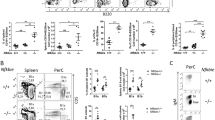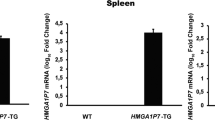Abstract
Dbl is the prototype of a large family of GDP–GTP exchange factors for small GTPases of the Rho family. In vitro, Dbl is known to activate Rho, Rac, and Cdc42 and to induce a transformed phenotype in murine fibroblasts. We previously reported that Dbl-null mice are viable and fertile but display defective dendrite elongation of distinct subpopulations of cortical neurons, suggesting a role of Dbl in controlling dendritic growth. To gain deeper insights into the role of Dbl in development and disease, we attempted a knock-in approach to create an endogenous allele that encodes a missense-mutation-mediated loss of function in the DH domain. We generated, by gene targeting technology, a mutant mouse strain by inserting a mutagenized human proto-Dbl cDNA clone expressing only the Dbl N terminus regulatory sequence at the starting codon of murine exon 1. Animals were monitored over a 21-month period, and necropsy specimens were collected for histological examination and immunohistochemistry analysis. Dbl knock-in mice are viable and did not manifest either decreased reproductive performances or gross developmental phenotype but revealed a reduced lifespan compared to wild-type (w.t.) mice and showed, with aging, a B cell lymphoproliferation that often has features of a frank diffuse large B cell lymphoma. Moreover, Dbl knock-in male mice displayed an increased incidence of lung adenoma compared to w.t. mice. These data indicate that Dbl is a tumor susceptibility gene in mice and that loss of function of Dbl DH domain by genetic missense mutations is responsible for induction of diffuse large B cell lymphoma.







Similar content being viewed by others
References
Cerione RA, Zheng Y (1996) The Dbl family of oncogenes. Curr Opin Cell Biol 8:216–222
Zheng Y (2001) Dbl family guanine nucleotide exchange factors. Trends Biochem Sci 26:724–732
Rossman KL, Der CJ, Sondek J (2005) GEF means go: turning on RHO GTPases with guanine nucleotide-exchange factors. Nat Rev Mol Cell Biol 6:167–180
Ron D, Tronick SR, Aaronson SA, Eva A (1988) Molecular cloning and characterization of the human dbl proto-oncogene: evidence that its overexpression is sufficient to transform NIH/3T3 cells. EMBO J 7:2465–2473
Bi F, Debreceni B, Zhu K, Salani B, Eva A, Zheng Y (2001) Autoinhibition mechanism of proto-Dbl. Mol Cell Biol 21:1463–1474
Ron D, Graziani G, Aaronson SA, Eva A (1989) The N-terminal region of proto-dbl down regulates its transforming activity. Oncogene 4:1067–1072
Eva A, Aaronson SA (1985) Isolation of a new human oncogene from a diffuse B-cell lymphoma. Nature 316:273–275
de Franciscis V, Rosati R, Colucci-D’Amato GL, Eva A, Vecchio G (1991) Preferential expression of the dbl protooncogene in some tumors of neuroectodermal origin. Cancer Res 51:4234–4237
Vecchio G, Cavazzana AO, Triche TJ, Ron D, Reynolds CP, Eva A (1989) Expression of the dbl proto-oncogene in Ewing’s sarcomas. Oncogene 4:897–900
Colucci-D’Amato GL, Santelli G, D’Alessio A, Chiappetta G, Mineo A, Manzo G, Vecchio G, de F V (1995) Dbl expression driven by the neuron specific enolase promoter induces tumor formation in transgenic mice with a p53(+/−) genetic background. Biochem Biophys Res Commun 216:762–770
Eva A, Graziani G, Zannini M, Merin LM, Khillan JS, Overbeek PA (1991) Dominant dysplasia of the lens in transgenic mice expressing the dbl oncogene. New Biol 3:158–168
Hirsch E, Pozzato M, Vercelli A, Barberis L, Azzolino O, Russo C, Vanni C, Silengo L, Eva A, Altruda F (2002) Defective dendrite elongation but normal fertility in mice lacking the Rho-like GTPase activator Dbl. Mol Cell Biol 22:3140–3148
Pasteris NG, Cadle A, Logie LJ, Porteous ME, Schwartz CE, Stevenson RE, Glover TW, Wilroy RS, Gorski JL (1994) Isolation and characterization of the faciogenital dysplasia (Aarskog–Scott syndrome) gene: a putative Rho/Rac guanine nucleotide exchange factor. Cell 79:669–678
Graham FL, van der Eb AJ (1973) Transformation of rat cells by DNA of human adenovirus 5. Virology 54:536–539
Zangrilli D, Eva A (1995) Cell transformation by dbl oncogene. Methods Enzymol 256:347–358
Sander EE, van Delft S, ten Klooster JP, Reid T, van der Kammen RA, Michiels F, Collard JG (1998) Matrix-dependent Tiam1/Rac signaling in epithelial cells promotes either cell–cell adhesion or cell migration and is regulated by phosphatidylinositol 3-kinase. J Cell Biol 143:1385–1398
Li R, Debreceni B, Jia B, Gao Y, Tigyi G, Zheng Y (1999) Localization of the PAK1-, WASP-, and IQGAP1-specifying regions of Cdc42. J Biol Chem 274:29648–29654
Galland F, Pirisi V, de Lapeyriere O, Birnbaum D (1991) Restriction and complexity of Mcf2 proto-oncogene expression. Oncogene 6:833–839
Haines DC, Chattopadhyay S, Ward JM (2001) Pathology of aging B6;129 mice. Toxicol Pathol 29:653–661
Rose ML, Birbeck MS, Wallis VJ, Forrester JA, Davies AJ (1980) Peanut lectin binding properties of germinal centres of mouse lymphoid tissue. Nature 284:364–366
Tian W, Liou HC (2009) RNAi-mediated c-Rel silencing leads to apoptosis of B cell tumor cells and suppresses antigenic immune response in vivo. PLoS ONE 4:e5028
Rosenwald A, Wright G, Chan WC, Connors JM, Campo E, Fisher RI, Gascoyne RD, Muller-Hermelink HK, Smeland EB, Giltnane JM et al (2002) The use of molecular profiling to predict survival after chemotherapy for diffuse large-B-cell lymphoma. N Engl J Med 346:1937–1947
Gilmore TD, Kalaitzidis D, Liang MC, Starczynowski DT (2004) The c-Rel transcription factor and B-cell proliferation: a deal with the devil. Oncogene 23:2275–2286
Hunt KE, Reichard KK (2008) Diffuse large B-cell lymphoma. Arch Pathol Lab Med 132:118–124
Sahai E, Marshall CJ (2002) RHO-GTPases and cancer. Nat Rev Cancer 2:133–142
Bustelo XR (2000) Regulatory and signaling properties of the Vav family. Mol Cell Biol 20:1461–1477
Ornitz DM, Hammer RE, Messing A, Palmiter RD, Brinster RL (1987) Pancreatic neoplasia induced by SV40 T-antigen expression in acinar cells of transgenic mice. Science 238:188–193
Ellenbroek SI, Collard JG (2007) Rho GTPases: functions and association with cancer. Clin Exp Metastasis 24:657–672
Komai K, Mukae-Sakairi N, Kitagawa M, Shiozawa S (2003) Characterization of novel splicing variants of the mouse MCF-2 (DBL) proto-oncogene. Biochem Biophys Res Commun 309:906–909
Komai K, Okayama R, Kitagawa M, Yagi H, Chihara K, Shiozawa S (2002) Alternative splicing variants of the human DBL (MCF-2) proto-oncogene. Biochem Biophys Res Commun 299:455–458
Ueda S, Kataoka T, Satoh T (2004) Role of the Sec14-like domain of Dbl family exchange factors in the regulation of Rho family GTPases in different subcellular sites. Cell Signal 16:899–906
Lee JH, Katakai T, Hara T, Gonda H, Sugai M, Shimizu A (2004) Roles of p-ERM and Rho-ROCK signaling in lymphocyte polarity and uropod formation. J Cell Biol 167:327–337
Carrel L, Willard HF (2005) X-inactivation profile reveals extensive variability in X-linked gene expression in females. Nature 434:400–404
Cattoretti G, Mandelbaum J, Lee N, Chaves AH, Mahler AM, Chadburn A, Dalla-Favera R, Pasqualucci L, MacLennan AJ (2009) Targeted disruption of the S1P2 sphingosine 1-phosphate receptor gene leads to diffuse large B-cell lymphoma formation. Cancer Res 69:8686–8692
Dalla-Favera R, Gaidano G (2001) Molecular biology of lymphomas. In: De Vita VT, Hellman S, Rosenberg SA (eds) Cancer principles and practice of oncology. Lippincott Williams & Wilkins, Philadelphia, pp 2215–2235
Acknowledgments
The authors are indebted to Dr. V. Pistoia, Laboratory of Oncology, and Dr. I. Airoldi A.I.R.C. Laboratory of Immunology and Tumors, G. Gaslini Institute, for helpful discussions. The authors would like to thank Maria Grazia Calevo, Epidemiology and Biostatistics Section, G. Gaslini Institute, and Fabiola Blengio and Paolo Fardin, Laboratory of Molecular Biology, G. Gaslini Institute, for help with statistical analysis and Sara Barzaghi, Laboratory of Molecular Biology, G. Gaslini Institute, for secretarial assistance. This work was supported by grants from the Italian Association for Cancer Research, from the Compagnia di S. Paolo, and from the Ministero della Salute. CT was supported by Compagnia di S. Paolo (4824 SD/CV-2007.2880).
Conflicts of interest
The authors reported no potential conflicts of interest.
Author information
Authors and Affiliations
Corresponding author
Additional information
Marzia Ognibene, Ottavia Barbieri, and Cristina Vanni contributed equally to this work.
Electronic supplementary material
Below is the link to the electronic supplementary material.
ESM 1
(PDF 1134 kb)
Rights and permissions
About this article
Cite this article
Ognibene, M., Barbieri, O., Vanni, C. et al. High frequency of development of B cell lymphoproliferation and diffuse large B cell lymphoma in Dbl knock-in mice. J Mol Med 89, 493–504 (2011). https://doi.org/10.1007/s00109-010-0712-4
Received:
Revised:
Accepted:
Published:
Issue Date:
DOI: https://doi.org/10.1007/s00109-010-0712-4




